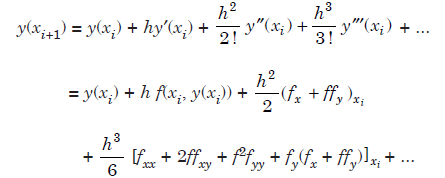SKEDSOFT
Runge Kutta Methods: A method of numerically integrating ordinary differential equations by using a trial step at the midpoint of an interval to cancel out lower-order error terms
Integrating the differential equation y′ = f (x, y) in the interval [xi, xi 1], we get
 .........................1.1
.........................1.1
We have noted in the previous section, that y′ and hence f (x, y) is the slope of the solution curve. Further, the integrand on the right hand side is the slope of the solution curve which changes continuously in [xi, xi 1]. By approximating the continuously varying slope in [xi, xi 1] by a fixed slope, we have obtained the Euler, Heun’s and modified Euler methods. The basic idea of Runge-Kutta methods is to approximate the integral by a weighted average of slopes and approximate slopes at a number of points in [xi, xi 1]. If we also include the slope at xi 1, we obtain implicit Runge-Kutta methods. If we do not include the slope at xi 1, we obtain explicit Runge-Kutta methods. For our discussion, we shall consider explicit Runge-Kutta methods only. However, Runge-Kutta methods must compare with the Taylor series method when they are expanded about the point x = xi. In all the Runge-Kutta methods, we include the slope at the initial point x = xi, that is, the slope f(xi, yi).
Runge-Kutta method of second order :
Consider a Runge-Kutta method with two slopes. Define

 .......................1.1
.......................1.1
where the values of the parameters c2, a21, w1, w2 are chosen such that the method is of highest possible order. Now, Taylor series expansion about x = xi, gives
 ....................1.2
....................1.2
We also have,

Substituting the values of k1 and k2 in (1.2), we get,
 .................1.3
.................1.3